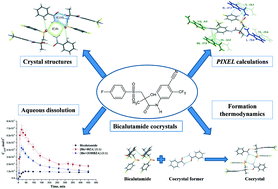Cocrystals of the antiandrogenic drug bicalutamide: screening, crystal structures, formation thermodynamics and lattice energies†
Abstract
Two new cocrystals of the non-steroidal anti-androgen drug bicalutamide (Bic) are reported with benzamide (BZA) and salicylamide (2OHBZA), both in a 1 : 1 molar ratio. X-ray crystal structure analysis shows that both cocrystals contain a folded molecular conformation of bicalutamide, similar to that seen in polymorph II of the pure drug. Calculations of intermolecular interaction energies using the PIXEL approach indicate closely comparable total lattice energies for [Bic + BZA] and [Bic + 2OHBZA]. The structures are dominated by dispersion interactions, with a significant contribution also from the coulombic interactions, particularly in [Bic + BZA]. The main difference between the two cocrystals is seen for the bicalutamide–cocrystal former interaction energy, which is calculated to be slightly more stabilizing in [Bic + BZA]. The melting temperatures of the cocrystals (132 °C for [Bic + BZA] and 157 °C for [Bic + 2OHBZA]) are significantly lower than that of the pure API (193 °C). In general, the melting temperatures of all known bicalutamide cocrystals are shown to increase with an increase of the total van der Waals volume (Vvdw) of the molecules in the asymmetric unit of the crystal. The thermodynamic functions of the cocrystal formation were estimated from the solubility of the cocrystals and the corresponding solubility of the pure compounds in chloroform at various temperatures. In both cases, the Gibbs energy of formation was found to be small: −3.4 kJ mol–1 for [Bic + BZA] and −2.2 kJ mol−1 for [Bic + 2OHBZA]. The most significant contribution to the Gibbs energy is provided by the exothermic enthalpy of formation. However, the cocrystal formation is accompanied by a considerable decrease of the system entropy, which diminishes the overall driving force of the process. Both cocrystals demonstrated a classical “spring and parachute” behavior during aqueous dissolution, providing an increased concentration level of Bic compared to that of the parent drug for several hours.


 Please wait while we load your content...
Please wait while we load your content...